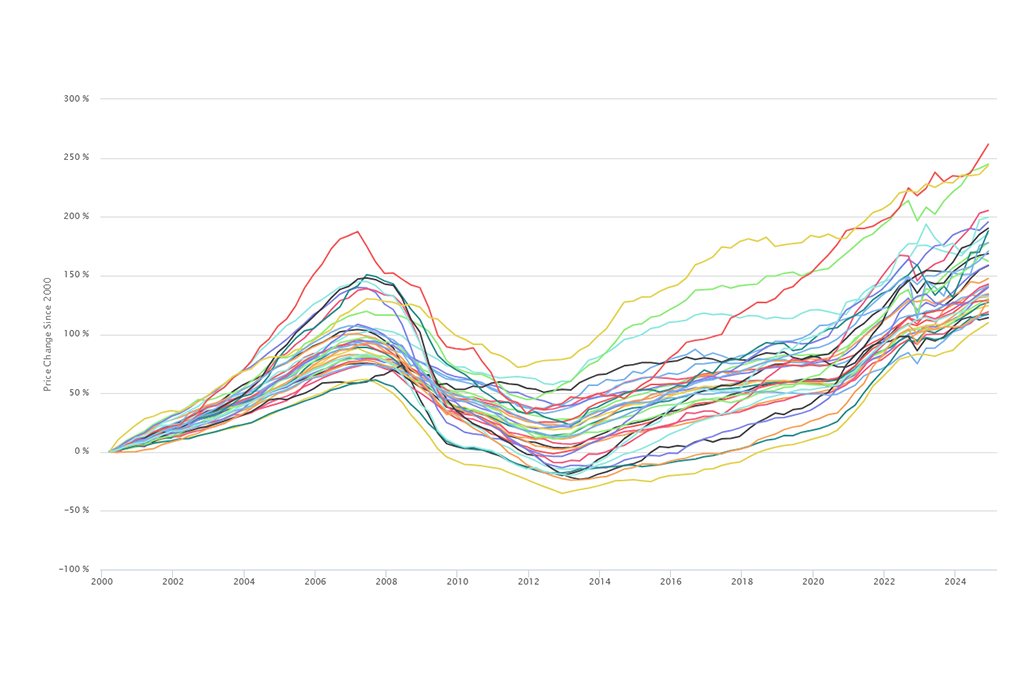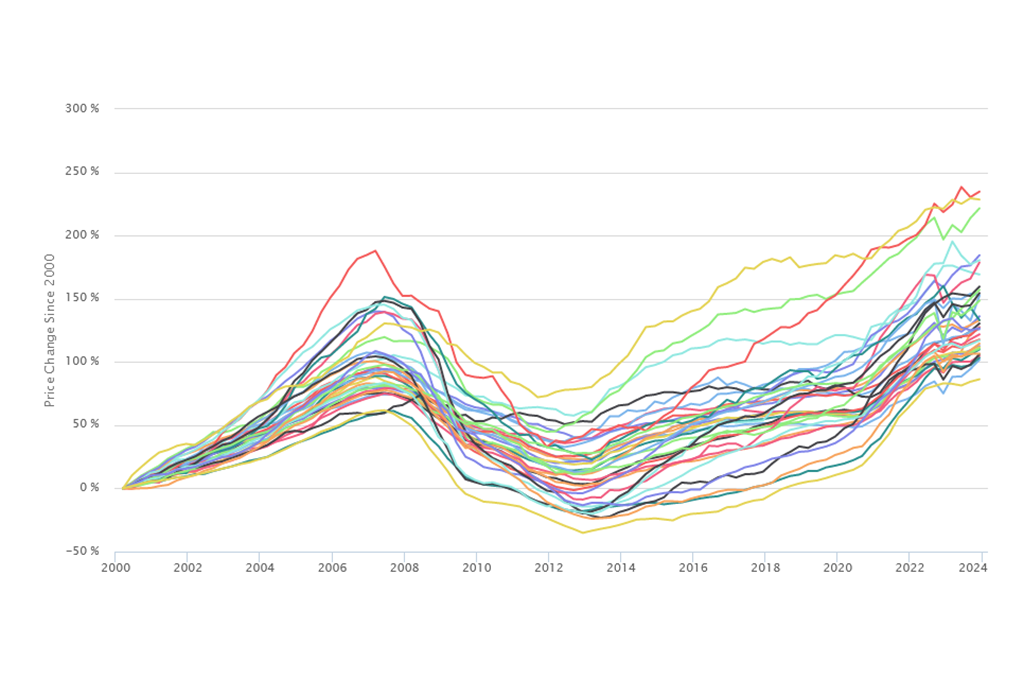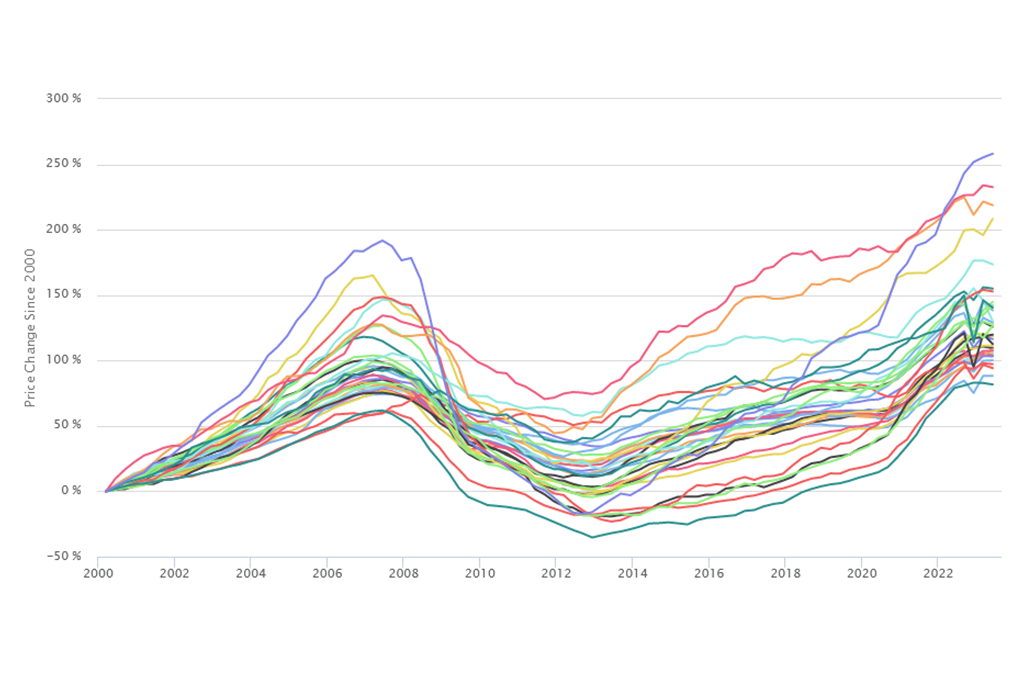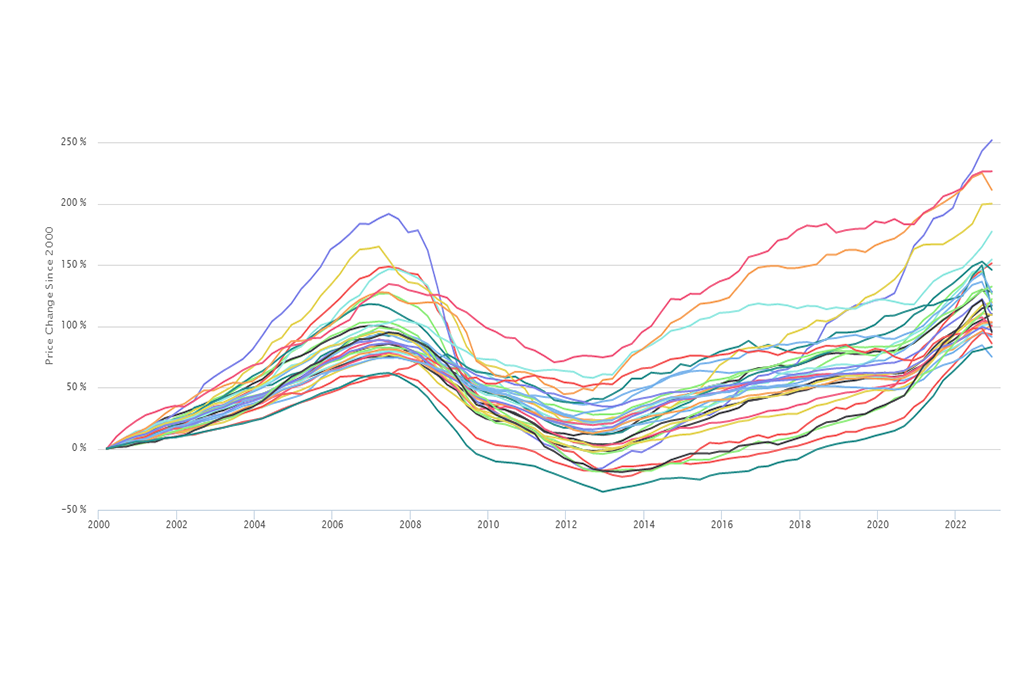The Second Quarter 2013 IHS Cook County House Price Index reflects house price changes on single family properties with repeat sales from the first quarter of 1997 through the second quarter of 2013. This release of the Index focuses exclusively on quarterly price changes for single family homes and tracks the variation in price changes between areas that have experienced different levels of concentrated foreclosure activity throughout the housing crisis. Neighborhood foreclosure levels are determined by the share of residential parcels that have had at least one foreclosure filing between 2005 and 2012.
For a detailed description of how the IHS Cook County House Price Index is calculated, click here. For each release o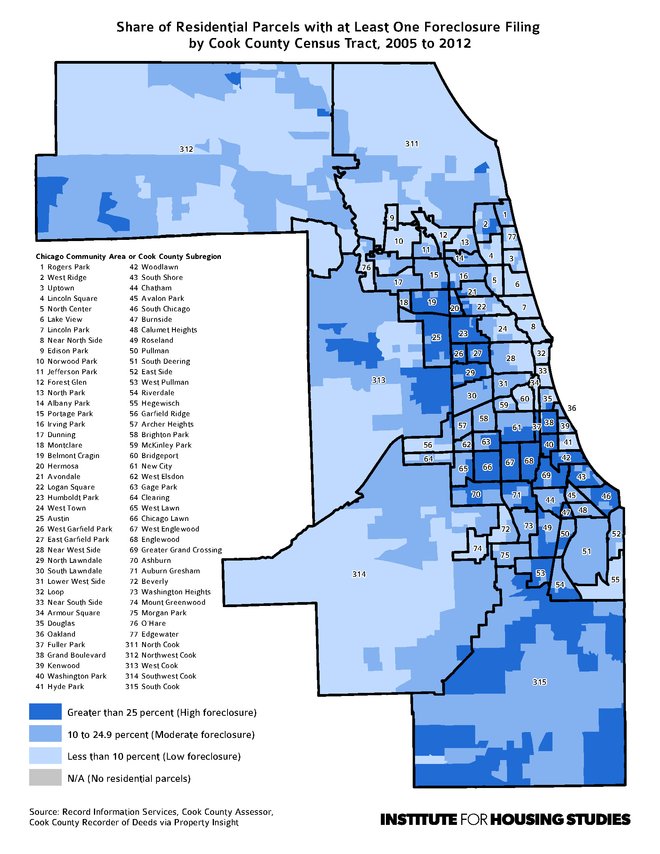 caption textf the Index, tabular data is available for download. The numbers reported here are seasonally adjusted. For access to all downloadable materials, click the download link at the bottom of the page.
caption textf the Index, tabular data is available for download. The numbers reported here are seasonally adjusted. For access to all downloadable materials, click the download link at the bottom of the page.
The Second Quarter 2013 Index shows the recent price recovery in the single family housing market in Cook County as well as the long-term impact that the housing crisis has had on house prices in the most foreclosure-distressed communities. Countywide, single family home prices were up more than nine percent year over year with the City of Chicago experiencing stronger price increases than suburban Cook County.
The geographically concentrated pattern of foreclosure activity in Cook County throughout the housing crisis, however, means that long-term price trends and recent improvements in house prices look different in areas that have had higher and lower levels of foreclosure activity. Areas where foreclosure has directly impacted very few properties have emerged from the housing crisis relatively stable and have seen strong recent price growth. Meanwhile, areas where more than a quarter of properties have had at least one foreclosure filing experienced much more dramatic price declines. In these areas, single family homes have seen more limited recent price increases and are at price levels well below what they were in 2000.
Key Trends from Second Quarter 2013:
- Single family home prices in Cook County continue positive trends. Figure 1 illustrates the long-term single family home price trends in Cook County and in the two major subregions of Cook County: the City of Chicago and suburban Cook. It shows that in the second quarter of 2013, Cook County single family home prices experienced their second consecutive positive quarter, and, since reaching a low point in the first quarter of 2012, single family prices have seen increases in four of five quarters. Year over year, prices were up by more than nine percent compared to the second quarter of 2012. Prices in the second quarter of 2013 saw particularly strong growth compared to the first quarter of 2013, increasing by nearly seven percent. Despite these recent price increases, single family home prices are still down by 34 percent when compared to the peak of the market.
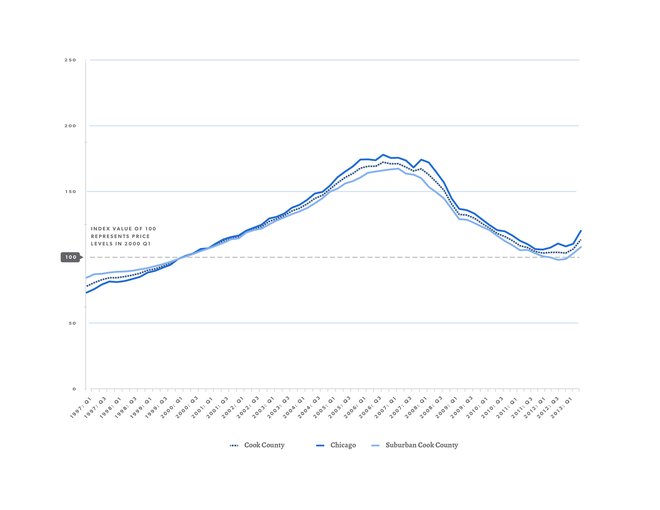 Figure 1. Price Changes for Single Family Homes from Q1 1997 to Q2 2013 in Cook County.
Figure 1. Price Changes for Single Family Homes from Q1 1997 to Q2 2013 in Cook County.
- Within Cook County, single family home prices increased faster in the City of Chicago than in suburban Cook County. Prices for single family homes in the City of Chicago increased by nearly 12 percent compared to the second quarter of 2012. Prices for single family homes in suburban Cook County saw year-over-year increases of just under eight percent. Both the City and suburbs saw strong increases from the first quarter of 2013. Single family home prices in the City of Chicago increased by nearly nine percent quarter over quarter and in the suburbs by nearly five percent quarter over quarter. In the City of Chicago, single family home prices have seen increases in four of five quarters since reaching a low point in the first quarter of 2012. Suburban Cook single family home prices have experienced three consecutive positive quarters since hitting a low in the third quarter of 2012.
 Table 1. Price Index Values and Change for Single Family Homes from Q1 1997 to Q2 2013 in Cook County.
Table 1. Price Index Values and Change for Single Family Homes from Q1 1997 to Q2 2013 in Cook County.
- Single family home price trends vary by levels of concentrated foreclosure activity in a neighborhood. Using a different repeat-sales model, the following discussion compares long-term price trends for single family homes in areas with low, moderate, and high levels of foreclosure activity. Areas with low levels of foreclosure distress are neighborhoods where less than 10 percent of all residential parcels have had at least one foreclosure filing between 2005 and 2012. Areas with moderate levels of foreclosure distress are those where between 10 and 24.9 percent of all residential parcels have been directly impacted by foreclosure. In areas with high levels of foreclosure activity, more than 25 percent of residential parcels have had at least one foreclosure filing between 2005 and 2012. Figure 2 highlights areas in Cook County considered low, moderate, and high foreclosure. It shows low foreclosure areas primarily located in central and on the North Side of Chicago and in North, Northwest, and Southwest suburban Cook County. High foreclosure areas are largely concentrated in the South and West Sides of Chicago and in parts of South and West Suburban Cook County.
 caption textFigure 2. Share of Residential Parcels with at Least One Foreclosure Filing by Cook County Census Tract, 2005 to 2012.
caption textFigure 2. Share of Residential Parcels with at Least One Foreclosure Filing by Cook County Census Tract, 2005 to 2012.
- Areas with the lowest level of foreclosure activity have the most price stability and strongest recent price gains. Figure 3 shows single family home price trends for areas with low, moderate, and high levels of foreclosure activity and illustrates that low foreclosure areas have emerged from the crisis on relatively strong footing. In the second quarter 2013, prices in these areas were 17 percent less than when at peak levels. This is compared to single family home prices in moderate foreclosure areas that are roughly 39 percent less than their peak. Overall, low foreclosure areas have seen long-term price growth. Since 2000, prices have increased over 36 percent in these more stable areas. Prices in the second quarter 2013 in these markets have increased over 5 percent from the previous quarter and have increased by nearly 9 percent year over year since the second quarter 2012. This is compared to just over five percent year over year price increases in moderate foreclosure areas.
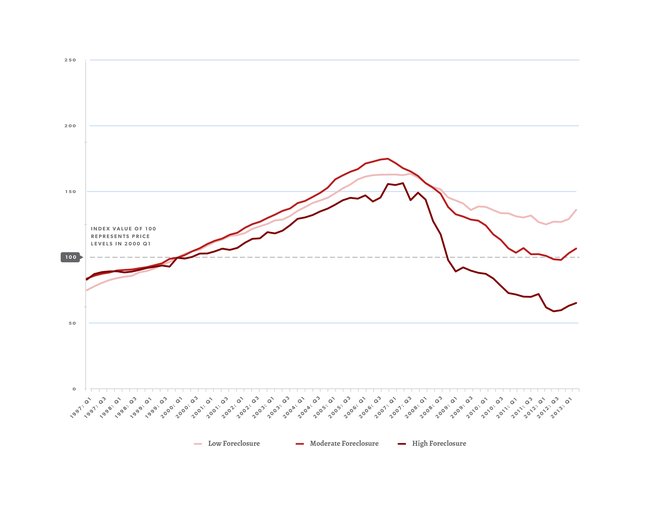 Figure 3. Price Change for Single Family Homes in Cook County by Neighborhood Foreclosure-Distress Level, Q1 1997 to Q2 2013.
Figure 3. Price Change for Single Family Homes in Cook County by Neighborhood Foreclosure-Distress Level, Q1 1997 to Q2 2013.
- High foreclosure areas have seen the most dramatic decline in single family home prices and limited recent price recovery. Table 2 illustrates that, from their peak, prices on single family homes in highly foreclosure-distressed markets have declined by over 58 percent as of the second quarter 2013. Examining long-term price changes independent of the boom period, prices of single family homes in the second quarter 2013 were approximately 34 percent less than they were in 2000. These areas have seen small price increases since second quarter 2012. Year over year, prices have increased 5.3 percent in highly foreclosure distressed neighborhoods in Cook County.
 Table 2. Price Index Values and Change for Single Family Homes in Cook County by Neighborhood Foreclosure-Distress Level, Q1 1997 to Q2 2013.
Table 2. Price Index Values and Change for Single Family Homes in Cook County by Neighborhood Foreclosure-Distress Level, Q1 1997 to Q2 2013.
Discussion
Recent price trends show the single family housing market in Cook County in the early phases of a recovery with quarter-over-quarter price increases in four of the last five quarters and strong year-over-year growth in the second quarter of 2012. This recovery is being led by neighborhoods with strong housing markets that have relatively stable house prices and have seen limited foreclosure activity during the course of the housing crisis. The data also show that neighborhoods with the highest levels of concentrated foreclosure activity are also experiencing recent price increases, but the housing crisis has had a much more significant impact on single family home price levels in these areas. Single home prices in these highly distressed communities declined dramatically from peak levels and remain well below 2000 levels.
Data Sources
To calculate the IHS Cook County House Price Index, the Institute uses data on property sales from the Cook County Recorder of Deeds (via Property Insight) and Midwest Real Estate Data. IHS also uses data from the Cook County Assessor's Office to determine property characteristics, price tiers, and the weighting of different types of property sales. Data on foreclosure filings activity is collected from the Cook County Recorder of Deeds via Property Insight and from Record Information Services. For more information, click here.

